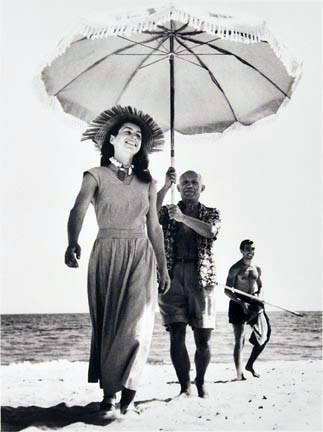About the Photographer
Capa, Robert
Hungarian, 1913-1954
"If your photographs aren't good enough, you're not close enough." --Robert Capa
Robert Capa was known as “The Greatest War Photographer in the World.†Born Friedmann Endre Ernő in Budapest, Hungary, he left his home country at the age of eighteen to study at the Deutsche Hochschule für Politik in Berlin, Germany, where he also worked for the German picture agency Dephot. When the Third Reich came to power in 1933, he left Berlin and settled in Paris. There he met Polish journalist and photographer Gerda Taro (born Gerta Pohorylle), with whom he became romantically involved and invented the persona of the “famous†American photographer Robert Capa. Together, the “three†of them (Ernő, Taro, and the imaginary Capa) formed an association in which Taro served as sales representative and Ernő served as the darkroom printer for Capa. Accrediting Ernő’s images of depression-era social and industrial strife to the persona of Capa (which means “shark†in Hungarian) enabled Taro to sell Ernő’s photos to French newspapers for much higher rates than he would have been able to obtain on his own. When the ruse was discovered, Ernő permanently assumed the name Robert Capa as his own.
Capa established his reputation as a war correspondent during the Spanish Civil War. On July 12, 1937, LIFE magazine published what became one of Capa’s most famous images, of a Spanish Loyalist soldier falling at the instant he was shot in the head, and in 1938 Picture Post published a spread of twenty-six of Capa’s photographs of the war under the title “The Greatest War Photographer in the World: Robert Capa.†After Gerda Taro, also on assignment covering the Spanish Civil War, was killed, Capa travelled to China and then immigrated to New York. He went on assignment for LIFE during World War II, covering much of the heaviest fighting in Africa, Italy, and Sicily, as well as the Battle of Normandy on June 6, 1944. Significantly, of the over one hundred frames Capa shot on D-Day, only eleven survived after a darkroom technician melted the emulsion while attempting to dry the film too quickly. Though blurred from the technician’s error, LIFE published some of the surviving shots with captions describing the images as being “slightly out of focus†due to Capa’s hands shaking with excitement, which Capa denied. Capa later entitled his memoir of the war with this phrase, “Slightly Out of Focus.â€
Capa became an American citizen in 1946, and the following year he co-founded the first cooperative agency of international freelance photographers, Magnum Photos, with Henri Cartier-Bresson, George Rodger, David 'Chim' Seymour, and William Vandivert. Capa covered the 1948 Arab-Israeli War and subsequently served as director of the Magnum office in Paris between 1950 and 1953. On May 25, 1954, Capa was killed by a land mine in Thai Binh, Vietnam, while on assignment for LIFE magazine covering the French Indochina War. He was awarded the Croix de Guerre with Palm by the French army posthumously, and in 1955 the Robert Capa Gold Medal Award for "best published photographic reporting from abroad requiring exceptional courage and enterprise" was established. In 2007 the International Center of Photography in New York (founded by Capa’s brother, Cornell) obtained “the Mexican suitcase,†lost in France in 1940 with the approach of the German army but discovered decades later in Mexico City, containing 4500 negatives of the Spanish Civil War by Capa, Gerda Taro, and David 'Chim' Seymour, taken between May 1936 and spring 1939.
Capa’s work has been exhibited internationally. Publications featuring his photographs include Death in the Making (1938, with Gerda Taro), Slightly Out of Focus (1947), Images of War (1964/65), Children of War, Children of Peace (1991), Robert Capa: Photographs (1996), and Robert Capa: The Definitive Collection (2001).




